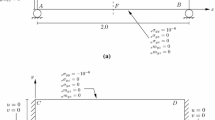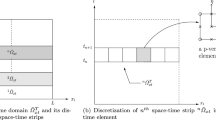Abstract
This paper considers dynamic behavior of non-classical thermoelastic solid continua. The mathematical model consists of the conservation and balance laws of non-classical continuum mechanics that incorporates additional physics of internal rotations arising due to deformation gradient tensor. We consider plane stress behavior with small deformation, small strain physics only. Galerkin Method with Weak Form (GM/WF) in space is considered to construct a space–time decoupled finite element formulation giving rise to ordinary differential equations (ODEs) in time containing mass matrix, stiffness matrix due to classical as well as non-classical physics and acceleration and displacement associated with nodal degrees of freedom. This formulation is utilized to: (1) study natural undamped modes of vibration (2) study transient dynamic response by time integrating the ODEs in time (3) study the transient dynamic response by transforming the ODEs in time to modal basis using eigenvectors of the undamped natural modes. The ODEs in modal basis are used to construct transient dynamic response by time integrating them as well as by considering their analytical solutions. The solutions of the model problem obtained using the mathematical model based on non-classical continuum mechanics with internal rotations are presented and are compared with those obtained using the mathematical model based on classical continuum mechanics to demonstrate the influence of new physics due to internal rotations on the dynamic response of solid continua.









Similar content being viewed by others
References
Eringen AC (1964) Mechanics of micromorphic materials. In: Gortler H (ed) Proceedings of the 11th international congress of applied mechanics, pp 131–138
Eringen AC (1968) Mechanics of micromorphic continua. In: Kroner E (ed) Mechanics of generalized continua, pp 18–35
Eringen AC (1968) Theory of micropolar elasticity. In: Liebowitz H (ed) Fracture
Eringen AC (1970) Balance laws of micromorphic mechanics. Int J Eng Sci 8:819–828
Eringen AC (1990) Theory of thermo-microstretch fluids and bubbly liquids. Int J Eng Sci 28:133–143
Eringen AC (1999) Theory of micropolar elasticity. Springer, New York
Eringen AC (1966) A unified theory of thermomechanical materials. Int J Eng Sci 4:179–202
Eringen AC (1967) Linear theory of micropolar viscoelasticity. Int J Eng Sci 5:191–204
Eringen AC (1972) Theory of micromorphic materials with memory. Int J Eng Sci 10:623–641
Koiter W (1964) Couple stresses in the theory of elasticity, I and II. Nederl Akad Wetensch Proc Ser B 67:17–44
Oevel W, Schröter J (1981) Balance equations for micromorphic materials. J Stat Phys 25:645–662
Reddy JN (2007) Nonlocal theories for bending, buckling and vibration of beams. Int J Eng Sci 45:288–307
Reddy JN, Pang SD (2008) Nonlocal continuum theories of beams for the analysis of carbon nanotubes. J Appl Phys 103:023511
Reddy JN (2010) Nonlocal nonlinear formulations for bending of classical and shear deformation theories of beams and plates. Int J Eng Sci 48:1507–1518
Lu P, Zhang PQ, Leo HP, Wang CM, Reddy JN (2007) Nonlocal elastic plate theories. Proc R Soc A 463:3225–3240
Yang JFC, Lakes RS (1982) Experimental study of micropolar and couple stress elasticity in compact bone in bending. J Biomech 15:91–98
Lubarda VA, Markenscoff X (2000) Conservation integrals in couple stress elasticity. J Mech Phys Solids 48:553–564
Ma HM, Gao XL, Reddy JN (2008) A microstructure-dependent Timoshenko beam model based on a modified couple stress theory. J Mech Phys Solids 56:3379–3391
Ma HM, Gao XL, Reddy JN (2010) A nonclassical Reddy–Levinson beam model based on modified couple stress theory. J Multiscale Comput Eng 8:167–180
Reddy JN (2011) Microstructure dependent couple stress theories of functionally graded beams. J Mech Phys Solids 59:2382–2399
Reddy JN, Arbind A (2012) Bending relationship between the modified couple stress-based functionally graded Timoshenko beams and homogeneous Bernoulli–Euler beams. Ann Solid Struct Mech 3:15–26
Srinivasa AR, Reddy JN (2013) A model for a constrained, finitely deforming elastic solid with rotation gradient dependent strain energy and its specialization to von Kármán plates and beams. J Mech Phys Solids 61:873–885
Mora RJ, Waas AM (2007) Evaluation of the micropolar elasticity constants for honeycombs. Acta Mech 192:1–16
Onck PR (2002) Cosserat modeling of cellular solids. C R Mecanique 330:717–722
Segerstad PH, Toll S, Larsson R (2009) A micropolar theory for the finite elasticity of open-cell cellular solids. Proc R Soc A 465:843–865
Grioli G (2003) Microstructures as a refinement of Cauchy theory. Problems of physical concreteness. Contin Mech Thermodyn 15:441–450
Grekova EF, Maugin GA (2005) Modelling of complex elastic crystals by means of multi-spin micromorphic media. Int J Eng Sci 43:494–519
Altenbach J, Altenbach H, Eremeyev VA (2010) On generalized Cosserat-type theories of plates and shells: a short review and bibliography. Arch Appl Mech 80:217–227
Lazar M, Maugin GA (2005) Nonsingular stress and strain fields of dislocations and disclinations in first strain gradient elasticity. Int J Eng Sci 43:1157–1184
Lazar M, Maugin GA (2004) Defects in gradient micropolar elasticity—I: screw dislocation. J Mech Phys Solids 52:2263–2284
Maugin GA (1978) A phenomenological theory of ferroliquids. Int J Eng Sci 16:1029–1044
Maugin GA (1981) Wave motion in magnetizable deformable solids. Int J Eng Sci 19:321–388
Maugin GA (1988) Wave motion in magnetizable deformable solids, philosophical transactions of the royal society of london. Ser A Math Phys Eng Sci 356:1367–1395
Cosserat E, Cosserat F (1909) Théorie des corps déformables
Green AE (1965) Micro-materials and multipolar continuum mechanics. Int J Eng Sci 3:533–537
Green AE, Rivlin RS (1967) The relation between director and multipolar theories in continuum mechanics. Zeitschrift fü, r angewandte Mathematik und Physik ZAMP 18:208–218
Green AE, Rivlin RS (1964) Multipolar continuum mechanics. Arch Ration Mech Anal 17:113–147
Surana KS, Powell MJ, Reddy JN (2015) A more complete thermodynamic framework for solid continua. J Therm Eng 1:1–13
Surana KS, Powell MJ, Nunez D, Reddy JN (2015) A polar continuum theory for solid continua. Int J Eng Res Ind Appl 8:77–106
Surana KS, Powell MJ, Reddy JN (2015) Constitutive theories for internal polar thermoelastic solid continua. J Pure Appl Math Adv Appl 14:89–150
Surana KS, Joy AD, Reddy JN (2016) A non-classical internal polar continuum theory for finite deformation of solids using first Piola–Kirchhoff stress tensor. J Pure Appl Math Adv Appl 16:1–41
Surana KS, Joy AD, Reddy JN (2016) Non-classical internal polar continuum theory for finite deformation and finite strains in solids. Int J Pure Appl Math 4:59–97
Surana KS, Joy AD, Reddy JN (2017) Non-classical continuum theory for solids incorporating internal rotations and rotations of Cosserat theories. Continuum Mech Thermodyn 29:665–698
Surana KS, Joy AD, Reddy JN (2017) Non-classical continuum theory for fluids incorporating internal and Cosserat rotation rates. Continuum Mech Thermodyn 29:1249–1289
Surana KS, Shanbhag RR, Reddy JN (2017) Necessity of balance of moment of moments balance law in non-classical continuum theories for solid continua. Meccanica 53:2939–2972
Surana KS (2015) Advanced mechanics of continua. Taylor and Francis, Boca Raton
Eringen AC (1967) Mechanics of continua. Wiley, Hoboken
Prager W (1945) Strain hardening under combined stresses. J Appl Phys 16:837–840
Reiner M (1945) A mathematical theory of dilatancy. Am J Math 67:350–362
Todd JA (1948) Ternary quadratic types. Philos Trans R Soc Lond Ser A Math Phys Sci 241:399–456
Rivlin RS, Ericksen JL (1955) Stress-deformation relations for isotropic materials. J Ration Mech Anal 4:323–425
Rivlin RS (1955) Further remarks on the stress-deformation relations for isotropic materials. J Ration Mech Anal 4:681–702
Wang CC (1969) On representations for isotropic functions, part I. Arch Ration Mech Anal 33:249
Wang CC (1969) On representations for isotropic functions, part II. Arch Ration Mech Anal 33:268
Wang CC (1970) A new representation theorem for isotropic functions, part I and part II. Arch Ration Mech Anal 36:166–223
Wang CC (1971) Corrigendum to my recent papers on “epresentations for isotropic functions”. Arch Ration Mech Anal 43:392–395
Smith GF (1970) On a fundamental error in two papers of C. C. Wang, on representations for isotropic functions, part I and part II. Arch Ration Mech Anal 36:161–165
Smith GF (1971) On isotropic functions of symmetric tensors, skew-symmetric tensors and vectors. Int J Eng Sci 9:899–916
Spencer AJM, Rivlin RS (1959) The theory of matrix polynomials and its application to the mechanics of isotropic continua. Arch Ration Mech Anal 2:309–336
Spencer AJM, Rivlin RS (1960) Further results in the theory of matrix polynomials. Arch Ration Mech Anal 4:214–230
Spencer AJM (1971) Theory of invariants, Chapter 3. In: Eringen AC (ed) Treatise on continuum physics, I. Academic Press, New York
Boehler JP (1977) On irreducible representations for isotropic scalar functions. J App Math Mech/Zeitschrift für Angewandte Mathematik und Mechanik 57:323–327
Zheng QS (1993) On the representations for isotropic vector-valued, symmetric tensor-valued and skew-symmetric tensor-valued functions. Int J Eng Sci 31:1013–1024
Zheng QS (1993) On transversely isotropic, orthotropic and relatively isotropic functions of symmetric tensors, skew-symmetric tensors, and vectors. Int J Eng Sci 31:1399–1453
Surana KS, Reddy JN (2017) The finite element method for initial value problems. Taylor and Francis, Boca Raton
Surana KS, Reddy JN (2016) The finite element method for boundary value problems: mathematics and computations. Taylor and Francis, Boca Raton
Bathe KJ, Wilson EL (1976) Numerical methods in finite element analysis. Prentice Hall, Englewood Cliffs
Acknowledgements
First author is grateful for his endowed professorships and the department of mechanical engineering of the University of Kansas for providing financial support to the second author. The computational facilities provided by the Computational Mechanics Laboratory of the mechanical engineering department are also acknowledged.
Author information
Authors and Affiliations
Corresponding author
Ethics declarations
Conflict of interest
The authors declare that they have no conflict of interest.
Additional information
In honor of Professor J. N. Reddy for his 75th Birthday.
Publisher's Note
Springer Nature remains neutral with regard to jurisdictional claims in published maps and institutional affiliations.
Rights and permissions
About this article
Cite this article
Surana, K.S., Carranza, C.H. Dynamic behavior of thermoelastic solid continua using mathematical model derived based on non-classical continuum mechanics with internal rotations. Meccanica 56, 1345–1375 (2021). https://doi.org/10.1007/s11012-020-01221-2
Received:
Accepted:
Published:
Issue Date:
DOI: https://doi.org/10.1007/s11012-020-01221-2




